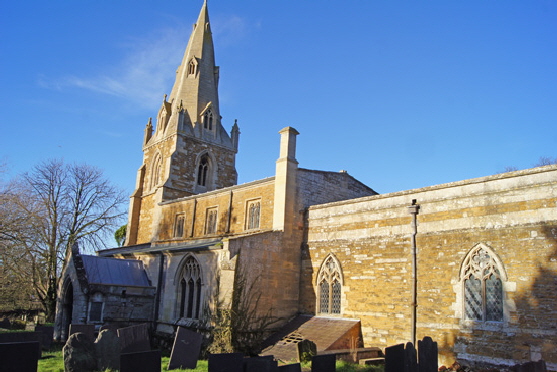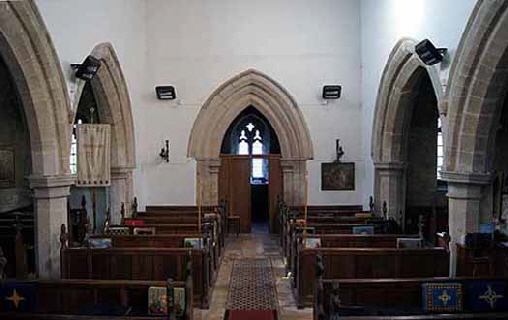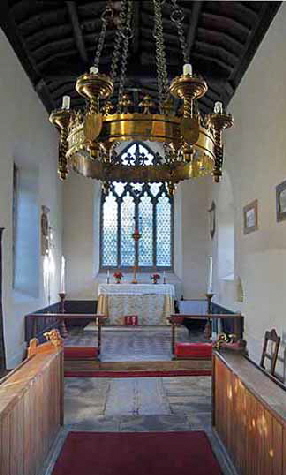|
Alphabetical List |
|
|
|
|
|
|
|
County List and Topics |
|
|
|
Please sign my Guestbook and leave feedback |
|
|
||||||||||||||||||||||||||||
|
frieze can, I think, be safely ascribed to that time. The Decorated style lucarnes (dormer windows for spires) are in the Decorated style so it seems likely it was built in the first half of the fourteenth century. The oldest part seems to be the nave where there are capitals with nail head decoration and sculpture clearly in the Early English style. Pevsner points to the reticulated tracery of the chancel as evidence that it was probably extended and/or remodelled - perhaps at the same time as the broach spire was added. It is tall, long and narrow. The clerestory and aisles are, however, in later Perpendicular style. We know that John Oakham was here to carve the font. Was he here with that simple commission or was he part of a larger group that was engaged in these more extensive works? The only clear evidence of further activity is in some of the label stops (carvings at the ends of the drip moulds that protect windows from water) that clearly are by John. Oakham. That does not, however, tell us whether the aisles were built at that time or whether the windows were being replaced. The clerestory shows no evidence at all that it was contemporary with the aisles. Its windows are rectangular and, to say the least undistinguished. They may be later than the early fifteenth century or the windows may have been changed during the Victorian restoration. Like the aisles It has no parapets and thus no gargoyles. The chancel on the other hand seems to have very high parapets and, again, no gargoyles. Altogether it is difficult to infer the extent of the program of work that John was involved with here. Finally, I have to mention the poppy head benches here that add a frisson of interest to the casual church crawler. In this neck of the woods such things are far from commonplace. |
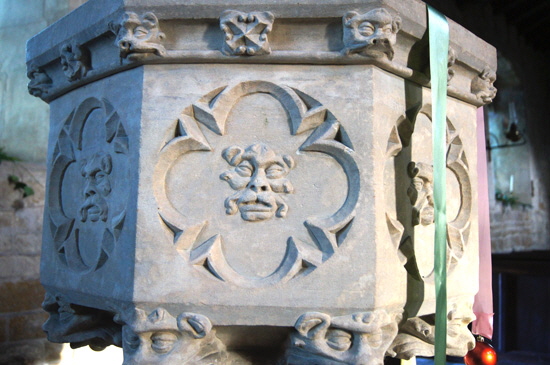 |
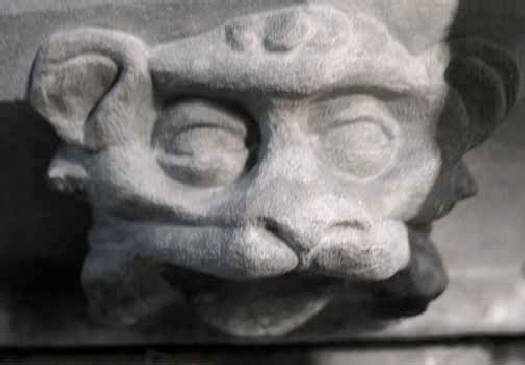 |
||||||||||
|
Let’s start with the font. It is an extraordinary thing for the early fifteenth century. It combines the octagonal shape the Gothic font with the unfathomable grotesques of some Romanesque fonts. There is not even a nod towards religious or allegorical themes. That this is the work of John Oakham there is absolutely no doubt. The peculiar cow-lion faces are seen all over the cornice friezes of Oakham and Brant Broughton Churches. Even the diagonal-shaped fleuron (middle of the rim in the picture left) is so frequent on his friezes that on its fairly generic nature prevents me from seeing it as his own trademark. The cow-lion heads support the bowl on its octagonal base, decorate the rim and also populate the font panels. |
|||||||||||
 |
|||||||||||
 |
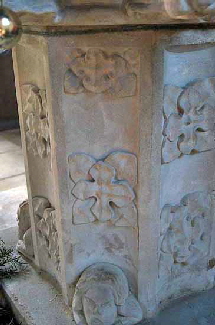 |
||||||||||
|
Left: One of the side panels, Centre: The octagonal stem. The sides are decorated with shallowly-carved fleurons very much of this era. Yet at each corner there s a human head with a foreign - almost oriental - appearance (see also pictures below). It was fairly commonplace, again, in the Romanesque era to have such corner carvings although more usually on the corners of the bowl, rather than on the base. Right: One of the supporter grotesques. The cow-like ears, the tufts of hair on the crown of the head and the well-carved unseeing eyes are all characteristic of John’s cornice frieze carvings. |
|||||||||||
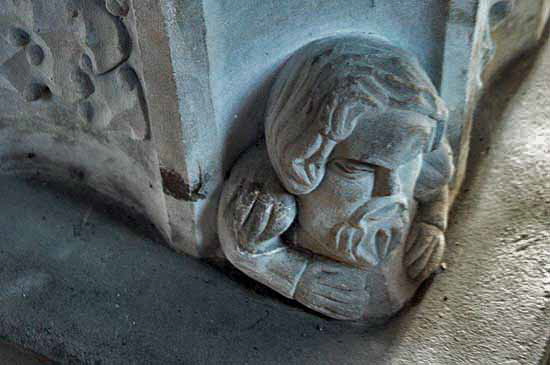 |
|||||||||||
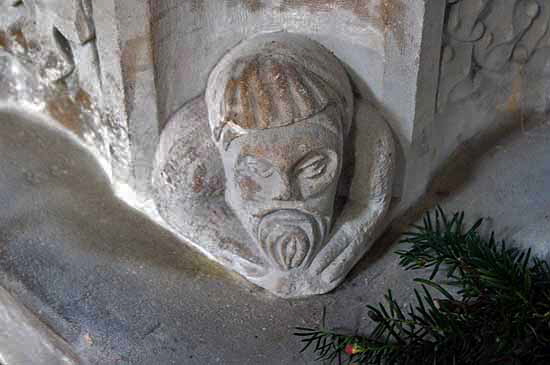 |
|||||||||||
|
Two the base corner carvings of human heads, What makes this font remarkable is that it demonstrates the work of a sculptural mason who feels “able to turn his hand to anything”. A “can do” attitude, if you like. Given a new challenge, however, John reverted to the style that he knew best to leave a somewhat anachronistic piece of work. It asks questions also of those who would contend that such sculpture should have “meaning”. It is difficult to think of any plausible meaning to this piece. John simply decorated it in the way he knew best and presumably the patrons and congregation were happy with that, perhaps chuckling at the imagery rather than questioning its aptness. It perhaps tell us a great deal of the “anything goes” attitude that the sculpture of John Oakham and the Mooning Men Group demonstrates throughout this area. |
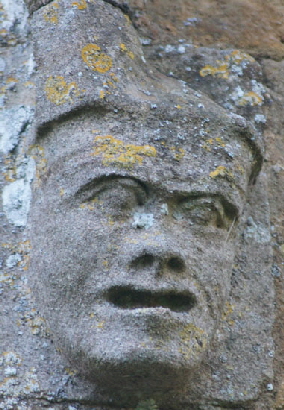 |
 |
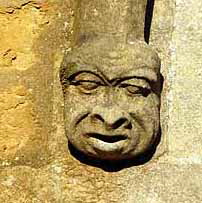 |
|||||||||
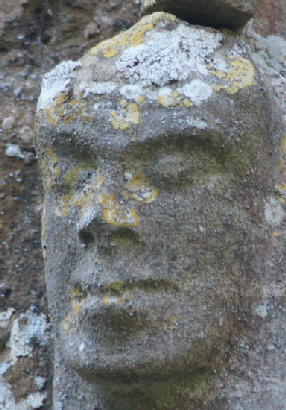 |
|||||||||||
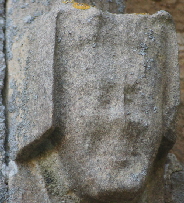 |
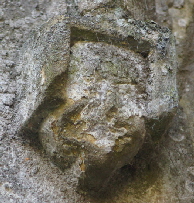 |
||||||||||
|
There is little doubt that John Oakham carved the label stops at Muston. Look at the sophisticated eye forms on some of these carvings, similar to those on the font here and to John’s label stops at the other Harlaxton Triangle churches. The two large images to the left are clearly people that John knew. It is my contention that John and other masons of the Demon Carver Group were reproducing the images of themselves and their fellow masons. There may also be, as commonly, supposed, images of patrons mixed in with these faces but the similarities of some of the designs - particularly at Ryhall and Lowesby - that convinces me that we are seeing masons commemorated in some of these sculptures. Note also, two examples of the ubiquitous goffered caul headdresses that allow us to date the imagery to the late fourteenth and early fifteenth centuries. |
|
|
||||||||||||||||||||||||||||||||
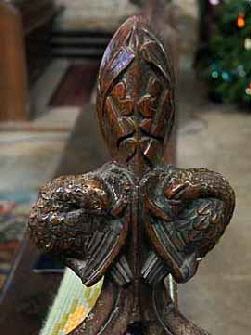 |
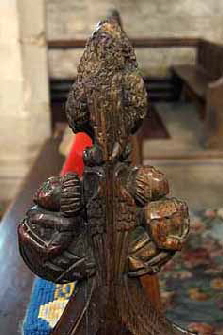 |
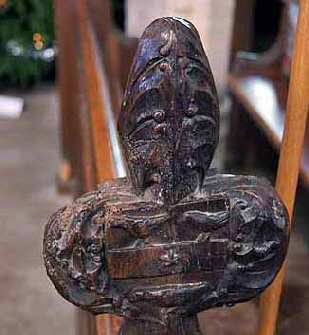 |
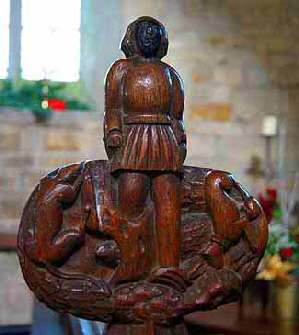 |
|
Fifteenth century poppy heads. Second Right we see the arms of the Colville family who were lords of the manor at the time.. Far Right is an intriguing puzzle. To the left and right of the standing figure are animals. That on the left seems to be a hound, his tail to the ground.. On the right is possibly his quarry, his tail to the air. The right leg of the human figure (left a we look) disappears into some sort of device. What on earth can it be? Another animal slinks behind the man’s legs, his head peeping out to the left. The body to the right looks spiny so I guess it is most likely a hedgehog. Below the man’s feet is what is probably meant to be a mass of foliage. |
 |
|||
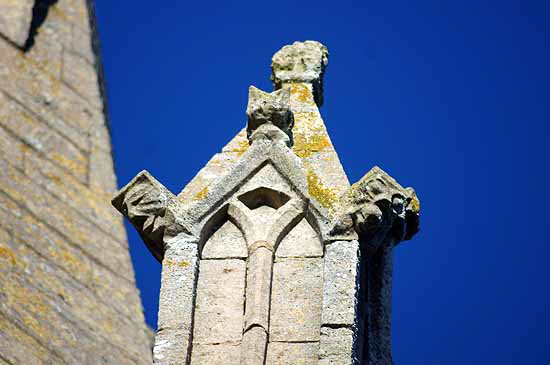 |
|||
|
Left: The tower with its broach spire. The lack of durability of Leicestershire ironstone is evinced by weathering at many churches and the exposed top sections of towers suffered particularly badly. It is conspicuous here that the limestone adornments have fared much better over the centuries. The existence of a sub-parapet frieze might beg the question of whether it was the work of John Oakham but the answer here, as at many local churches with broach spires, is surely no. Broach spires are naturally self-draining and require no parapets or gargoyles. This tower clearly pre-dates the the era of John Oakham and the Mooning Men Group of masons and this frieze was surely a decorative conceit carved at the time the tower and spire were built. There would be no conceivable reason for it to have been added subsequently. Right: The tower’s pinnacles are curiously solid and lacking in flamboyance. This tower, however, pre-dates the flamboyance that was to come during later decades. It is also always worth bearing in mind that although mediaeval masons showed a commendable “can do” mentality, just as with modern tradesmen what they could do and what they could do well were often two different things. Nevertheless (right) we can see that the mason responsible for these pinnacles did try to inject a little flair into his work with these (invisible from the ground) grotesque heads.. |
 |
||||||||||
|
A section of the tower’s cornice frieze. |
||||||||||
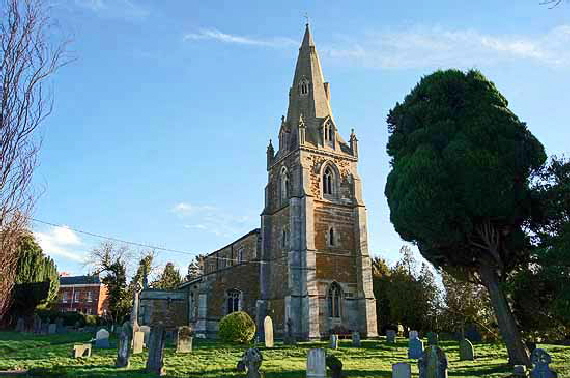 |
||||||||||
 |
||||||||||
|
Left: Perpendicular style window on the west end of the north aisle. The label stops are probably by John Oakham and note the goffered caul headdress typical of this period and inexplicably beloved of John Oakham and other masons of the Mooning Men Group. Right: The church from the north west. Not that there is a north as well as a south porch. This porch has rather more flamboyant pinnacles decorated with crockets. |
||||||||||
|
Footnote - Literary Connections |
||||||||||
|
The Church Guide (at least the one I picked up in 2013) is a curious thing with just four pages of photocopied text that covers not only the history of the church but also the village! Oddly, two pages of those four are devoted to a list of rectors. Two of these are particularly interesting, however. From 1789-1814 George Crabbe was rector here. From 1814-21 it was Henry Byron, uncle of Lord Byron. Crabbe was, in his day, a famous man and an intimate of such as Wordsworth, Scott and Byron, admirers all. Tennyson, however, was somewhat dismissive of his metronomic verse structures. He was not universally admired then and is perhaps even less so now although he is far from forgotten. His poetry was largely of rural life and perhaps his greatest claim to fame today is that a character in one of his poems was Peter Grimes the eponymous anti-hero of Britten’s opera. Crabbe was chaplain to the Dukes and Duchesses of Rutland at nearby Belvoir Castle (and who used Bottesford Church for their funerary monuments). He acquired the living at Muston as well as another church in Lincolnshire but in fact spent only three years at Muston from 1789 (the year of the storming of the Bastille to add some perspective) . Being the rector (the receiver of tithes and the so-called “living”) was not the same as being the resident priest. It seems that Crabbe was much more interested in his poetry than in things spiritual and apparently he had a very small stock of sermons that he re-used frequently. Much of his later life was spent in Trowbridge, Wiltshire where he was interred after his death. Off Henry Byron, I have been able to find little information but it is rather remarkable that George Crabbe was succeeded to his living at Muston by an uncle of his friend and, one has to imagine, not entirely a coincidence |
||||||||||
